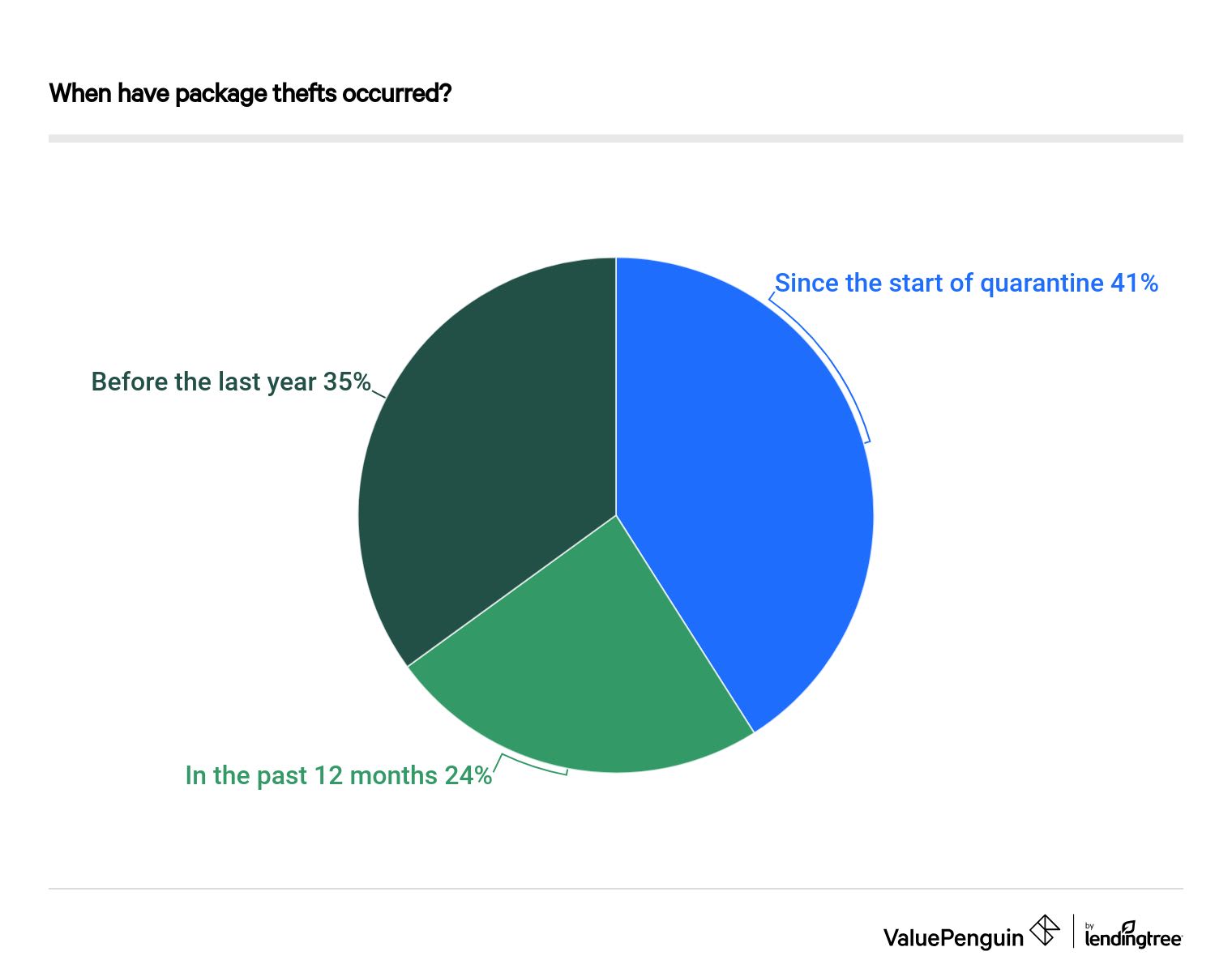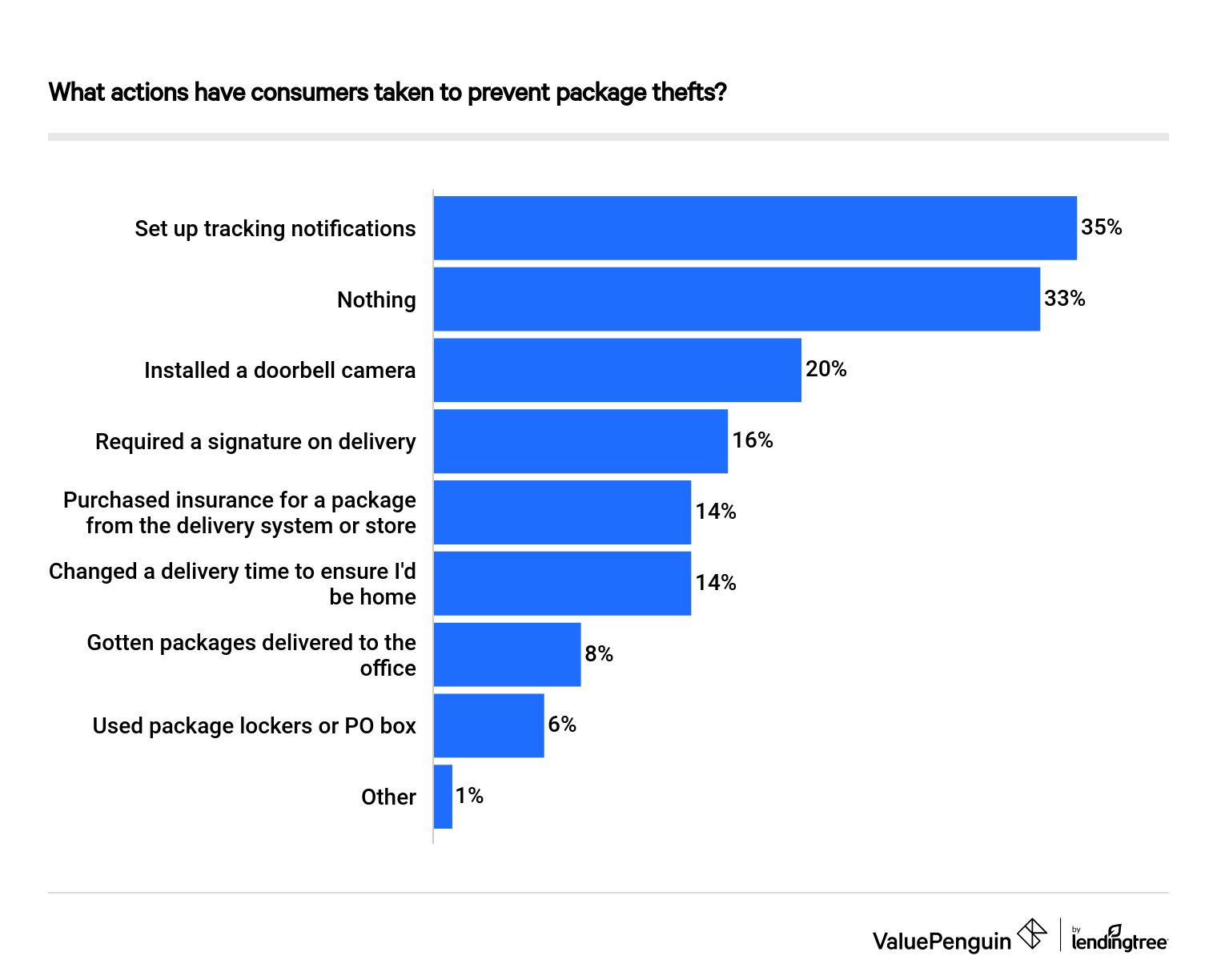Homeowners Insurance
Nearly 1 in 5 Consumers Experienced Package Theft Since the Start of Quarantine

The stay-at-home orders implemented due to the COVID-19 pandemic caused an uptick in deliveries — and thieves have taken notice. According to a recent ValuePenguin survey of more than 1,000 Americans, 18% of consumers have experienced package theft in the past four months.
These short-term thefts are part of a larger problem that consumers face even in a normal year. About 43% of survey respondents said they were victims of package theft at some point in the past. Furthermore, over 54% of respondents had multiple deliveries stolen in the past 12 months.
In spite of the prevalence of package thefts, many consumers aren't taking steps to mitigate the risk of losing a package. One-third of respondents said they have taken no action to reduce their chances of being a victim of porch piracy.
Key findings:
Nearly 1 in 5 consumers have been victims of porch piracy since the coronavirus crisis started, with 18% having had a package or delivery stolen. In all, 43% of consumers reported at least one package theft in the past.
Some people are more vulnerable to package theft than others. Gen Xers and millennials together reported more than 4 in 10 package thefts since the beginning of the pandemic, and they experienced 64% of the incidents reported in the past year.
About 30% of porch piracy victims did not get all of their money back, resulting in an average loss of $106. Less than half of the victims said the package thief was eventually caught.
While 14% of people who experienced a theft in the recent past said a grocery or meal delivery box was stolen, this number has actually decreased since the pandemic began.
Despite the continued risk of package theft, 33% of consumers have taken no action within the past year to prevent package thefts.
More than one-quarter of Americans know someone who has had a package stolen since the beginning of the COVID-19 crisis, while 18% reported having been targeted by thieves themselves.
Consumers' reliance on no-contact shopping during the COVID-19 crisis has contributed to the increase in package thefts. About 37% of survey respondents said they increased their package deliveries since the start of the pandemic. Of these consumers, millennials and Gen Xers accounted for the largest percentage — more than 40% of each age group reported receiving more deliveries since the beginning of the pandemic.
As a consequence of this increase in package deliveries, millennials and Gen Xers were the most likely to be victims of package theft. Together, these groups reported more than 42% of package thefts since the start of the pandemic, with Gen Zers following behind.

Since the start of the pandemic, about 40% of package thefts have happened to residents of apartment buildings, and more than one-quarter of the victims were living in a duplex.
Unexpectedly, most package thefts during quarantine weren't in states such as New York or New Jersey, where large proportions of the population live in apartment buildings. Instead, 24% of package thefts occurred in New England — the most of any US region.
Although package thefts have affected many Americans during the COVID crisis, this type of burglary isn't an isolated problem. An estimated 44% of Americans have had a package stolen at some point, most commonly from right outside their front door or their porch.
Older consumers are more likely than younger victims to lose valuable goods to thieves. And the overall average annual loss of property from package thefts in the past year was $106.
In the past 12 months, the average value lost to package theft was $106, with respondents reporting losses as high as $4,800 for a single package. During this time, Gen Zers were most frequently targeted, accounting for more than 41% of thefts. However, Gen Zers reported losing an average of only $21 in the entire year to thieves.
On the other hand, Americans at least 75 years old lost an average of $210 in the past year — $100 more than the average across all age groups. At the same time, these older shoppers only reported 12% of the thefts in the past year, meaning thieves were able to get a higher payout for each older victim they targeted.
In the past year, more than 57% of stolen packages were delivered by Amazon. During the same period, groceries delivered by services like HelloFresh and Instacart made up 14% of stolen packages. Conversely, during the pandemic, when the use of these services increased dramatically, groceries only made up 12% of stolen goods.
For those shoppers who did have a package stolen, most were able to recoup the full value of their lost items. Only three in 10 package theft victims said they weren't fully reimbursed. About 75% of respondents said they were paid back or received a free replacement item. However, more than 1 in 5 victims got back only some of their money after a theft.
One-third of people haven't taken any measures to protect themselves against porch pirates, but more than 8 in 10 millennials have.
Despite the abundance of package thefts, about one-third of all Americans haven't taken steps to reduce their chances of having their deliveries stolen. Specifically, about half of people over age 55 have taken no such measures.
On the other hand, more than 8 in 10 millennials have taken precautions meant to deter potential thieves. In fact, millennials were the most likely to take more than one step to stop future package thefts. About 35% of all residents who did take precautions opted to receive tracking notifications — the most common preventive measure — and 20% installed doorbell cameras.
Still, extra security might not always prevent thieves from making off with other people's deliveries. Overwhelmingly, the highest percentage of packages stolen in the past year — a whopping 57% — were taken from a property that employed a doorman or gate..

Most people who have experienced porch piracy did try to resolve the theft by filing a claim with the seller, contacting the shipping company or reporting the theft to law enforcement. In fact, only 4% of victims didn't do anything after having a package stolen. However, about 17% of Gen Z victims of package theft did nothing afterward.
About 14% of Americans purchased insurance directly from the shipper or retailer. This tends to be a better option than filing a claim with your homeowners or renters insurance after an item is stolen. While the best insurers cover stolen property, making a claim usually raises your premium. Typically, it's best to avoid using your insurance unless you've exhausted all other avenues and, even then, only use it when a high-value item is stolen.
Methodology
ValuePenguin commissioned Qualtrics to conduct an online survey of 1,020 Americans, with the sample base proportioned to represent the overall population. The survey was fielded June 12–15, 2020.
We defined generations as the following ages in 2020:
- Gen Z: ages 18 to 23
- Millennials: ages 24 to 39
- Gen X:ages 40 to 54
- Baby boomers: ages 55 to 74
- Silent generation: ages 75 and older
